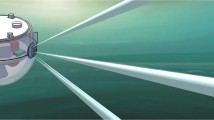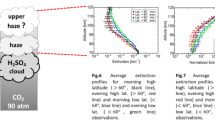Abstract
The interaction of the Aretic winter aerosol (Arctic haze) with solar radiation produces changes in the radiation field that result in the enhancement of scattering and absorption processes which alter the energy balance and solar energy distribution in the Arctic atmosphere-surface system. During the second Arctic Gas and Aerosols Sampling Project (AGASP II) field experiment, we measured radiation parameters using the NOAA WP-3D research aircraft as a platform. State-of-the-art instrumentation was used to measure in situ the absorption of solar radiation by the Arctic atmosphere during severe haze events. Simultaneously with the absorption measurements, we determined optical depths, and total, direct, and scattered radiation fields. All optical measurements were made at spectral bands centered at 412, 500, 675, and 778 nm and with a bandpass of 10 nm. With this selection of spectral regions we concentrated on the measurement of the radiative effects of the aerosol excluding most of the contributions by the gaseous components of the atmosphere. An additional measurement performed during these experiments was the determination of total solar spectrum fluxes. The experimentally determined parameters were used to define an aerosol model that was employed to deduce the absorption by the aerosols over the full solar spectrum and to calculate atmospheric heating rate profiles. The analyses summarized above allowed us to deduce the magnitude of the change in some important parameters. For example, we found changes in instantaneous heating rate of up to about 0.6 K/day. Besides the increased absorption (30 to 40%) and scattering of radiation by the atmosphere, the haze reduces the surface absorption of solar energy by 6 to 10% and the effective planetary albedo over ice surfaces by 3 to 6%. The vertical distribution of the absorbing aerosol is inferred from the flux measurements. Values for the specific absorption of carbon are found to be around 6 m2/g for externally mixed aerosol and about 11.7 m2/g for internally mixed aerosol. A complete study of the radiative effects of the Arctic haze should include infrared measurements and calculations as well as physics of the ice, snow, and water surfaces.
Similar content being viewed by others
5. References
Ackerman, T. P. and F. P. J. Valero, 1984, “The vertical structure of Arctic haze as determined from airborne net-flux radiometer measurements.” Geophys. Res. Lett., 11, 469–472.
Ackerman, T. P., J. N. Stemback, and F. P. J. Valero, 1986, “The importance of Aretic haze for the energy budget of the Arctic.” Arctic Air Pollution, Cambridge University Press, Cambridge, U. K., 151–158.
Barrie, L. A., R. M. Hoff, and S. J. Daggupaty, 1981, “The influence of mid-latitudinal pollution sources on haze in the Canadian Arctic.” Atm. Env., 15, 1407–1419.
Clarke, A. D. and K. J. Noone, 1985, “Soot in the Arctic snow pack, a cause for perturbations in radiative transfer.” Atm. Env., 19, 2045–2053.
Cuzzi, J. N., T. P. Ackerman, and L. C. Helmle, 1982, “The delta-four stream approximation for radiative flux transfer.” J. Atmos. Sci., 39, 917–925.
Hale, G. M. and M. R. Querry, 1973, “Optical constants of water in the 200 nm to 200 micron wavelength region.” Appl. Opt., 12, 555–563.
Heintzenberg, J., 1980, “Particle size distribution and optical properties of the Arctic haze.” Tellus, 32, 251–260.
Heintzenberg, J., 1982, “Size segregated measurements of particulate elemental carbon and aerosol light absorption at remote Arctic locations.” Atm. Env., 16, 2461–2469.
Janzen, J., 1980, “The extinction of light by highly nonspherical strongly-absorbing colloidal particles: spectro-optical determination of volume distributions for carbon blacks.” Appl. Opt., 19, 2977–2985.
King, M. D., D. M. Byrne, B. M. Herman, and J. A. Reagan, 1978, “Aerosol size distributions obtained by inversion of spectral optical depth measurements.” J. Atmos. Sci., 35, 2153–2167.
King, M. D., 1982, “Sensitivity of constrained linear inversions to the selection of the Lagrange multipliers.” J. Atmos. Sci., 39, 1356–1369.
McClatchey, R. A., R. W. Fenn, J. E. A. Selby, F. E. Volz, and G. S. Garing, 1972, “Optical properties of the atmosphere.” AFCRL report 72-0197, 3rd ed.
McCracken, M. C., R. D. Cess, and J. L. Potter, 1986, “Climatic effects of anthropogenic Arctic aerosols, an illustration of climatic feed back mechanisms with one and two dimensional climate models.” J. Geoph. Res., 91, 14445–14450.
Mitchel, J. M., Jr., 1957, “Visual range in the polar regions with particular reference to the Alaskan Arctic.” J. Atmos. and Terrest. Phys. Spec. Supp., Pt. I; 195–211.
Rahn, K. A. and R. J. McCaffrey, 1980, “On the origin and transport of the winter Arctic aerosol.” Ann. N. Y. Acad. Sci., 338, 486–503.
Rahn, K., R. Borys, and G. E. Shaw, 1977, “The Asian source of Aretic haze bands.” Nature, 268, No. 5622, 713–715.
Shaw, G. E., 1985, “Aerosol measurements in central Alaska.” Atmos. Env., 19, 2025–2032.
Shaw, G. E. and K. Stamnes, 1980, “Arctio haze; perturbation of the polar radiation budget.” Ann. N. Y. Acad. Sci., 338, 535–539.
Shaw, G. E., 1975, “The vertical distribution of atmospherio aerosols at Barrow, Alaska.” Tellus, 27, 39–50.
Toon, O. B., and T. P. Ackerman, 1981, “Algorithms for the calculation of scattering by stratified spheres.” Appl. Opt., 20, 3657–3660.
Valero, F. P. J., T. P. Ackerman, and W. J. Y. Gore, 1983, “Radiative effects of the Arctic haze.” Geophys. Res. Letter., 10, 1184–1187.
Valero, F. P. J., T. P. Ackerman, and W. J. Y. Gore, 1984, “The absorption of solar radiation by the Arctic atmosphere during the haze season and its effects on the radiation budget.” Geophys. Res. Lett., 11, 465–468.
Valero, F. P. J., and T. P. Ackerman, 1986, “Arctic haze and the radiation budget.” Arctic Air Pollution, B. Stonehouse, Ed. Cambridge University Press, Cambridge, U. K., 121–134.
Wendling, T., J. Finger, and R. Forkel, 1987, “On the influence of Arctic haze on the cloud topped boundary layer.” Aerosols and climate symposium, IUGG, Vancouver, Canada.
Author information
Authors and Affiliations
Rights and permissions
About this article
Cite this article
Valero, F.P.J., Ackerman, T.P. & Gore, W.J.Y. The effects of the Arctic haze as determined from airborne radiometric measurements during AGASP II. J Atmos Chem 9, 225–244 (1989). https://doi.org/10.1007/BF00052834
Received:
Issue Date:
DOI: https://doi.org/10.1007/BF00052834




